Beyond full ROM: 3 Lessons about stretch-mediated hypertrophy
Range of motion is a simple topic, right? “Use full ROM.” I’ve written before about the many studies showing that training over a larger ROM can stimulate more growth, more strength and more flexibility.
But there’s more to it. Here are 3 lessons on common misconceptions about ROM. Long-term subscribers should not fall for the first misconception, but in lessons 2 and 3 I’ll discuss 2 of the most interesting studies of the past year.
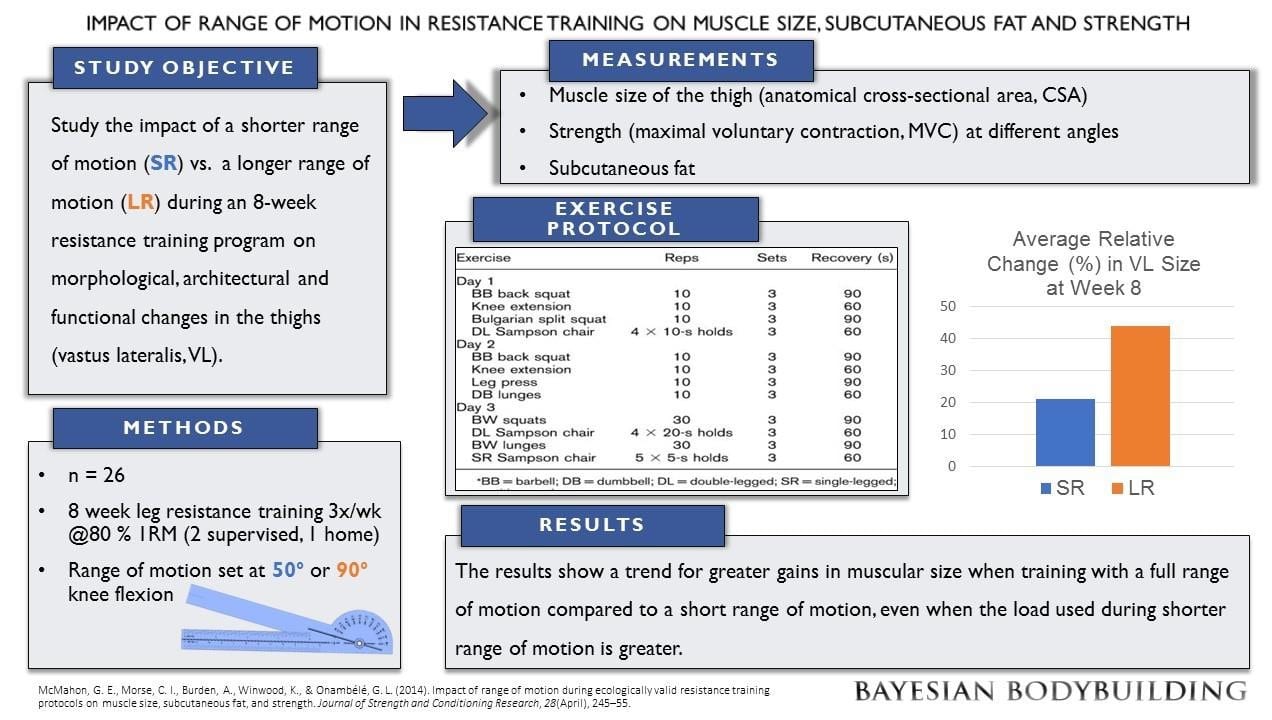
One of multiple studies showing deeper squats lead to more quad growth.
1. ROM is not defined by distance
First, let’s be clear on what ROM is. Many people have the idea that ROM is equal to the distance the bar travels. For example, during a bench press when the bar touches your chest, your pecs have achieved full ROM, right? And for a Romanian deadlift, the lower the bar goes, the greater the ROM, right? No and no.
ROM is measured in degrees, not distance, and it’s defined per joint, not per exercise. You can define the ROM of an exercise as well in certain cases, like with a bench press, but in the bottom position of a barbell bench press your pecs generally do not achieve a full stretch and that’s what matters for your muscles. During a Romanian deadlift (RDL), the ROM for your hips is primarily the result of how far your push your butt back: this defines the angle between your hips and your torso, the hip flexion angle. You can also lower the bar by letting your spine or shoulder blades round forward, but that’s generally not what you want. This distinction is important, because thinking of moving the bar often leads to poor technique. I’ve found that when my clients think of ‘lowering the bar’ and they get close to failure, they start rounding their back, letting the bar slip into their fingers and protracting their shoulder blades instead of fully pushing the hips back. A better cue during RDLs is: “push the hips back as far as possible.”
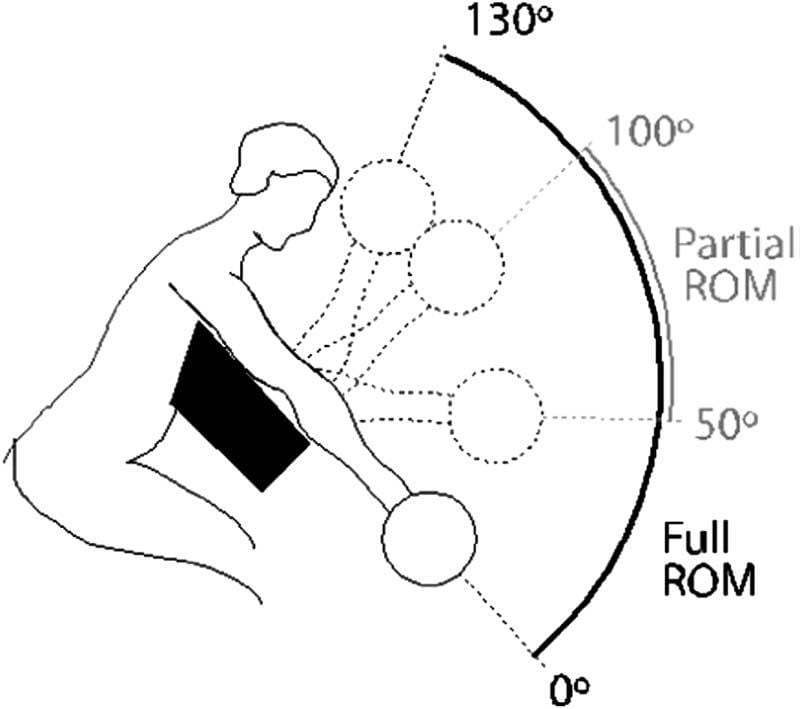
2. ROM doesn’t define the stimulus for muscle growth
Wait… what? Yes, technically, for muscle growth ROM is irrelevant and only muscle length matters. ROM refers to a joint’s mobility, not a muscle’s length. Strength is ROM-specific – you generally get strongest in the movements and positions you train in – so ROM matters for strength, but muscles don’t care about ROM per se, only their length. Muscles grow as an adaptation to high levels of mechanical tension. The level of tension that a muscle can produce varies across its length: this is called the length-tension relationship. As such, at which length you train a muscle determines how much tension you can subject it to. During dynamic exercises, your muscles change length as they contract to produce movement. For example, when you perform a biceps curl, your biceps shortens during the contraction. This is called functional excursion: the distance a muscle can shorten. So while ROM is important for strength, functional excursion is what really matters for muscle growth.
Of course, ROM and functional excursion correlate and sometimes they are practically the same. A full ROM chin-up, for example, can train the lats through pretty much their entire length. In this case, training with full ROM means training over the muscle’s full functional excursion. However, this is not nearly the case for all exercises and all muscles, especially not for multi-articulate muscles: muscles that span across 2 or more joints.
For example, a recent study by Maeo et al. (2021) compared seated and lying leg curls. A group of subjects performed the same training program with each leg for 12 weeks, except that one leg did seated leg curls, while the other leg did lying leg curls. While both exercises achieve full knee flexion ROM, the seated leg curls caused considerably more muscle growth in the hamstrings. This growth occurred specifically in the bi-articulate heads of the hamstrings. The simpler short head of the biceps femoris, which only performs knee flexion, grew similarly in response to both leg curls. Why did the hamstring heads that span across the hip grew more from seated leg curls? Because sitting stretches those heads at the hip. As a result, you train those heads of the hamstrings at longer muscle lengths with seated than with lying leg curls. This stimulates stretch-mediated hypertrophy.
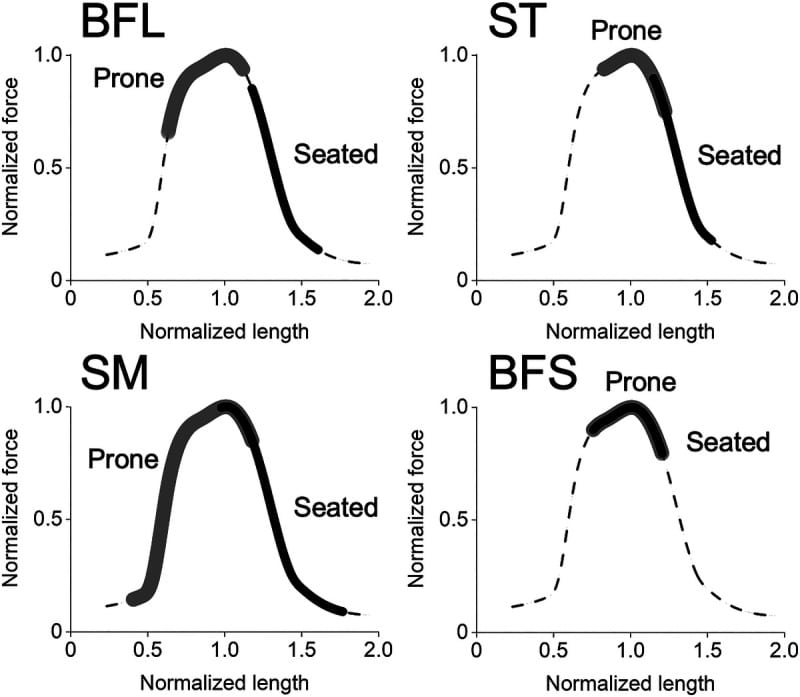
For the hardcore science lovers: the length-tension relation of the hamstrings and which part of this is trained by each head of the hamstrings. Source: Maeo et al. (2021)
The researchers did not dare speculate how stretch-mediated hypertrophy can occur, but I have some theories. First, stretch-mediated hypertrophy may occur via the addition of muscle sarcomeres in series rather than just in parallel: the muscle fascicles become longer, not just thicker. We know that strength training can stimulate an increase in muscle fascicle length, and it seems to be primarily heavy eccentric muscle contractions at long muscle lengths that achieve this, such as Romanian deadlifts for the hamstrings. Very hardcore machine-assisted stretching can also increase muscle fascicle lengths and induce muscle growth. And no, yoga or regular stretching doesn’t make your muscles longer: you need high mechanical tension.
Second, stretch-mediated hypertrophy may occur via passive mechanical tension. When muscles are stretched under load, they experience not just active muscle tension but also passive tension. Animal research that we cannot do in live humans shows passive mechanical tension stimulates muscle anabolic signaling just like active tension. In muscle cells, animals and bio-artificial muscles, the combination of muscle activation and stretching has been shown to strongly increase protein balance, anabolic gene expression, anabolic hormone signaling – particularly insulin-like growth factor-1 and mechano growth factor – and muscle growth [2, 3, 4, 5, 6, 7]. The titin muscle filament in particular experiences high tension during eccentric muscle contractions to a full stretch, as it’s effectively spring-loaded.
Stretch-mediated hypertrophy is the most well-supported mechanism for why full ROM training generally reigns supreme and paradoxically, it’s also the reason why training with full ROM does not guarantee maximal muscle growth. You need to stimulate stretch-mediated hypertrophy. Just using full ROM with random exercises may not cut it. In fact…
3. Stretch-mediated hypertrophy may be more important than full ROM
A recent study by Pedroso et al. (2021) found that in some situations, partial ROM training may actually be superior to full ROM training. The researchers had 4 groups of untrained women perform leg extensions in different ways.
- The end range ROM group performed only the top 30° of movement near full knee extension.
- The stretch ROM group performed only 35° of movement in the bottom.
- The ‘full’ ROM group performed both of the above ROMs, reaching 100° of movement. Technically, this isn’t full ROM, as most people have 120 or more degrees of knee extension ROM, but many leg extension machines don’t allow for more ROM than 100°.
- The varied ROM group alternated between the initial stretch ROM and the final end range ROM workouts.
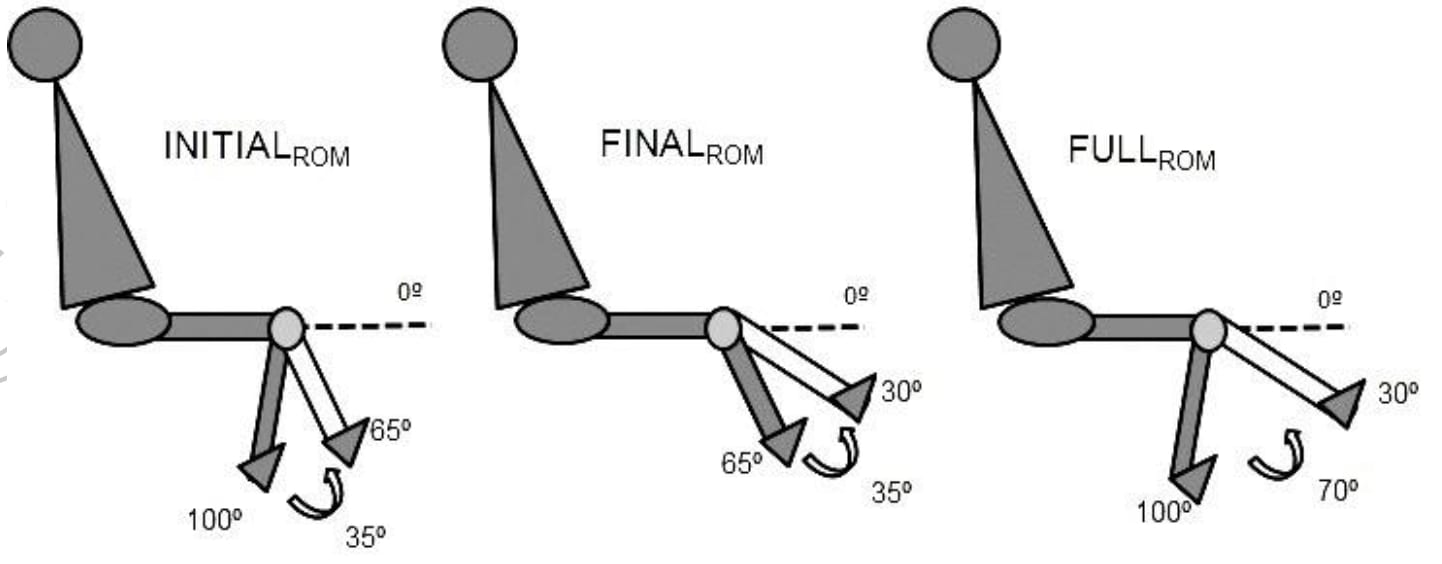
The 3 ranges of motion used by Pedroso et al. (2021)
Strength gains were a bit murky due to the surprising muscle growth results I’ll discuss next. However, the main finding of the strength data was evidence of ROM-specificity: training near lockout led to better strength gains near lockout and worse strength gains in the bottom, whereas training only the bottom ROM led to greater strength gains in the bottom and worse strength gains near lockout. This was as expected based on prior research. Strength is very specific to your training. That’s why it’s unfortunate we talk about strength as if it’s a trait, when it’s in fact a skill. We say someone ‘is’ strong, but that’s objectively quite inaccurate. Someone may ‘have a strong Powerlifting bench press’, but they may suck at squatting and even be mediocre at full ROM dumbbell bench pressing. You could say a powerlifter ‘is’ strong, but they may suck at Strongman competitions, CrossFit, 30 RMs, gymnastics, etc.
The really interesting results were the muscle growth data. Unlike in every other study so far except 1 curious study on triceps skull-crushers where muscle growth was only measured midway in the muscle, the full ROM group did not gain the most muscle. Instead, the stretch-only group gained the most muscle.
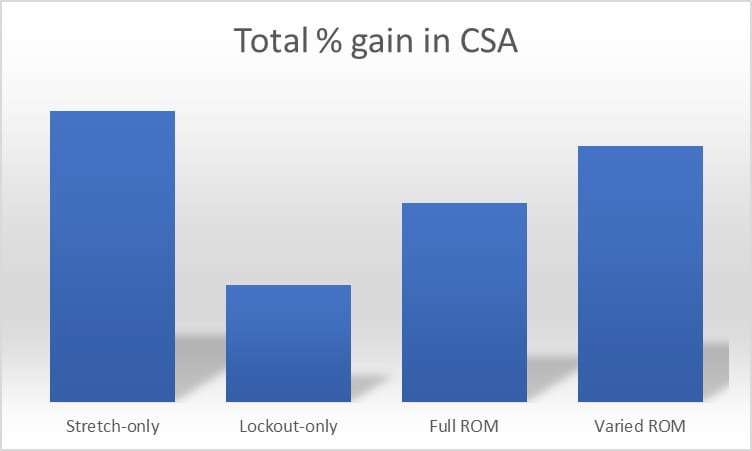
Muscle growth per group in Pedroso et al. (2021). The researchers didn’t report total quad growth, so I estimated the percentage gain per measured site from their graphs. Since this is no longer an intelligible measurement unit and I had to estimate the numbers, I didn’t include the y-axis with the exact numbers.
The researchers could not explain why the stretch-only group gained more muscle than the lockout-only group, as they trained with similar weights over similar ROMs: “this would seem to indicate that mechanical stress alone was not responsible for the observed differences; rather, muscular development appears to be driven via an interaction between mechanical stress and muscle length, the mechanisms of which are not clear.” In my mind, that the stretch-only group gained more muscle than the lockout-only group was not that surprising. This has been found before and even confirmed in a systematic review for isometric contractions. If you’re only going to train with a partial ROM, it better be the part where you get a good stretch, because then at least you’ll stimulate stretch-mediated hypertrophy. That’s the likely mechanism at play here and it does not defy mechanical tension. Rather, it’s precisely the (passive) mechanical tension from the stretch that likely stimulates the extra growth.
What did surprise me was that the stretch-only group also outperformed the full ROM group. You’d expect the full ROM group to also benefit from stretch-mediated hypertrophy, alongside any benefits of training the top part of the ROM. We know that muscles can experience regional hypertrophy. Different muscle fibers are activated to different degrees at different muscle lengths, in part because different fibers have different length-tension relations and because not all muscle fibers run along the entire length of the muscle fascicle. Plus, training over a full ROM is generally an efficient way to achieve a high area under the curve for mechanical tension. For example, during the bench press performing the top part of the movement should not considerably reduce how much you can lift. If you can get the bar halfway up, you should be able to lock it out. As such, the top part of the ROM may not be terribly effective to stimulate growth, but it’s ‘free volume’.
However, for exercises with an increasing gap between your strength curve and the resistance curve, doing the top part of the movement may induce a sticking point. Put simply, the top part of the movement can be so much more difficult that it limits how much you can lift. When you reach failure, you can’t produce enough force to perform the top part of the ROM anymore, but you could still do many reps with a smaller ROM. This is also the case with poorly designed leg extension machines, which unfortunately includes most leg extension machines. Indeed, in this study the full ROM group lifted significantly less weight than the stretch-only group. This is also the case with most rows, dumbbell curls and dumbbell lateral raises. These exercises leave the bottom part of the ROM very understimulated and, based on this study, miss out on stretch-mediated hypertrophy. I think usually leg extension machines are much more effective than dumbbell rows, curls and lateral raises, but this particular study had a few limitations that may have exacerbated how much the full ROM group missed out on a loaded stretch.
Limitation 1: the study participants didn’t train to failure, not remotely. They did 3 sets of 7 reps at 60% of their ROM-specific 1RM. The researchers said they did pilot research showing most people could not do more than 7 reps in the last set, and they build up the number of sets to 6 over the course of their 12-week training program, but women are normally very good, better than men, at high rep training. In my clients, women routinely crank out over 20 reps at 60% of 1RM. In a study I co-authored on the deadlift, we had women rep out on the deadlift at 60% of 1RM. One woman literally went up to around 80 reps and then said: “Ain’t nobody got time fo’ this. I can do this all day.” Ok, that’s not what she said. She went for the polite burn and asked if she should keep going. We told her it’s ok to stop, because we only wanted regular human subjects and she should fly back to planet Hala. Ok, that’s also not what we said. So many missed puns. Sigh. In any case, I’m not buying that this program was anywhere near failure for all participants and that would exacerbate how much the full ROM group understimulated the bottom position. When training close to failure, it’s plausible that a full ROM may suffice to reach enough tension in the bottom position to stimulate stretch-mediated hypertrophy. We know that training to complete failure is not necessary for maximum growth.
Limitation 2: the understimulation of the bottom position in the full ROM group was likely further exacerbated by the use of a 2-2 concentric-eccentric rep tempo. This largely prevents the full ROM group from using the stretch-shortening cycle, which would have allowed them to lift more weight and achieve higher muscle activity. The potentiating effect is largest for recent, large stretches before the concentric contraction.
Limitation 3: the subjects didn’t employ my advice to lean way back during leg extensions. Leg extensions are such a simple exercise that few people bother to optimize their technique, but this study supports it can actually make a significant difference to lean back. Leaning back lengthens the rectus femoris, the middle head of he quads, allowing it to produce considerably more tension. Try it. You can lift more weight and it’s because your quads are producing more tension, thus achieving a greater growth stimulus. Indeed, in this new study, it was mostly the rectus femoris that seemed to benefit from stretch-mediated hypertrophy. In the stretch-only group, the rectus femoris grew substantially more than the vastus lateralis, the outside head of the quads, whereas in the end range ROM and the full ROM groups, the 2 heads grew similarly.
So if you go close to failure on your leg extensions with an explosive tempo while leaning back, ideally in a leg extension machine that actually allows for full ROM (120° or more) and has a decent resistance curve, I doubt training with a full ROM will leave the bottom half understimulated. If you feel that it does, you may want to train to complete failure or incorporate partials in your program to ensure you get stretch-mediated hypertrophy. Exercises without a sticking point at the top most likely won’t benefit from stretch-only training. However, this is still a massive milestone study to highlight the importance of stretch-mediated hypertrophy.
How to take advantage of stretch-mediated hypertrophy
As I’ve argued before, many people fail to take advantage of stretch-mediated hypertrophy. Here are some examples of programs that fail to take advantage of stretch-mediated hypertrophy. These programs likely leave significant gains on the table.
For the glutes, some women forego squat type movements to isolate the glutes and prevent thigh growth. However, if all you do are hip thrust and hip abduction movements, you won’t stimulate stretch-mediated hypertrophy. You need squats or hip extension exercises.
For the lats, many people have no exercise in their program that stimulates stretch-mediated hypertrophy. Rows and deadlifts don’t even train the lats through nearly their full ROM, let alone do so with high tension. Pull-up and pulldown movements are better, but there’s still no tension in the top position due to the vertical angle of pull. You need an exercise like lat prayers to achieve stretch-mediated hypertrophy.
For arm training, many people fail to train both the biceps and the triceps in a stretched position. Regular dumbbell and barbell biceps curls achieve almost no tension at all in the stretched position and practically no compound exercise does either. The biceps needs an exercise like Bayesian curls to stimulate stretch-mediated hypertrophy. The long head of the triceps probably needs overhead extensions or skull-overs to achieve stretch-mediated hypertrophy. Pushdowns and endless press variations probably won’t cut it.
Conclusions
- ROM refers to joint mobility and is measured in degrees, not distance.
- Functional excursion is the distance a muscle can shorten. It’s measured in distance, akin to muscle length.
- Strength is ROM-specific: you become stronger primarily in the ROMs you train in.
- The stimulus for muscle growth is mechanical tension.
- The level of mechanical tension a muscle can produce depends on its current length: this is called the length-tension relationship.
- At long muscle lengths, muscles can experience not just active but also passive mechanical tension and this also seems to stimulate muscle growth.
- Training with full ROM does not guarantee you achieve stretch-mediated hypertrophy: you have to look at the muscle’s length, not just joint ROM. For example, seated leg curls can stimulate more muscle growth than lying leg curls, despite both achieving full knee flexion ROM.
- Stretch-mediated hypertrophy is likely more important for muscle growth than using a full ROM. In certain cases, partial ROM training can even stimulate more muscle growth than full ROM training, if the partial ROM exercise better stimulates stretch-mediated hypertrophy.
- Training muscles at short lengths may still be beneficial to optimize muscle growth due to emphasizing different muscle fibers.
- Many programs fail to stimulate stretch-mediated hypertrophy. Make sure your program puts the muscles you want to grow under high tension at long muscle lengths.
I hope this article gives you some ideas to optimize your training program and take advantage of stretch-mediated hypertrophy. Enjoy the gains!
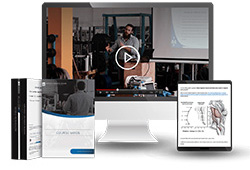 Want more content like this?
Want more content like this?
Then get our free mini-course on muscle building, fat loss and strength.
By filling in your details you consent with our privacy policy and the way we handle your personal data.
